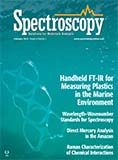The Impact of Illegal Artisanal Gold Mining on the Peruvian Amazon: Benefits of Taking a Direct Mercury Analyzer into the Rain Forest to Monitor Mercury Contamination
Illegal artisanal gold mining using mercury amalgamation is poisoning people and the ecosystem in the Amazon rain forest. By taking the technique of direct mercury analysis to a remote, field-based laboratory, the team of Professor Luis Fernandez is measuring the extent of the contamination in a wide variety of samples, including soil, fish, air and human hair.
This month's column describes the work of Professor Luis Fernandez and his team in the Department of Biology at Wake Forest University in Winston Salem, North Carolina, who are leading a project to study the effects of illegal artisanal gold mining using mercury amalgamation extraction on the human and environmental ecosystem of Peru's Madre de Dios region of the Amazon. By setting up a remote, field-based laboratory, they are monitoring mercury contamination in a wide variety of samples, including soil, fish, air, and human hair using the technique of direct mercury analysis (DMA).
This time last year, CNN showed a fascinating documentary about illegal artisanal gold mining in the Peruvian Amazon, where as many as 40,000 illegal miners (mostly poor, indigenous Indians from Peru's Andean highlands) had invaded some of the most pristine and biologically rich sections of ancient rain forest in the Amazon basin. In just a few years, the extraction and refining of the gold using mercury amalgamation has created more than 250,000 acres of desert in the middle of the Amazonian forest in Peru's southeastern Madre de Dios region (Figure 1). There was a truly memorable scene in the documentary when Bill Weir, the CNN reporter, came out of the lush rain forest on the back of a motorcycle to be confronted by a barren wasteland of sand as far as the eye could see, where all the trees had completely vanished. It seemed surreal that this kind of deforestation could be happening in the largest rain forest in the world, home to the highest biodiversity on our planet (1).
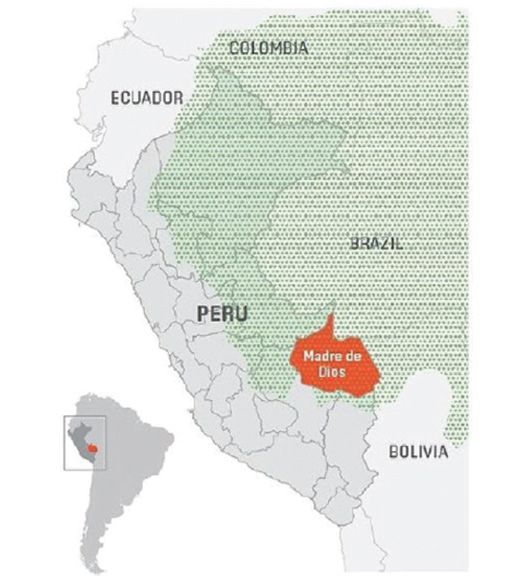
Figure 1: Peru's Madre de Dios region.
Gold Mining in Peru
Peru is the world's fifth largest gold producer, and the largest in Latin America, extracting about $10 billion worth a year, with approximately 20% mined from the Amazon region. Most of the gold comes from the Andean highland, by multinational companies from the United States, Canada, Brazil and China. However, artisanal and small-scale gold mining (ASGM) in the rain forest is different. Gold has been eroded from the mountains over millions of years, coming down alluvial river channels with other sediments and soils. Pulling the gold out of the ground is like mechanized soil-filtering, using dredgers and suction pumps to suck up the sediments and send them through crude wooden sluice boxes to separate the gold from the rocks. The heaviest particles, including the gold, settle on the bottom and are collected on strips of carpet; miners have to filter about one ton of dirt and mud to get an ounce of gold, so this is all about volume. The more earth you can suck up and sift out, the more money you can make. Since 2008, when the financial crisis led nervous investors to invest in gold, the price has stayed relatively high, peaking at about $1900 an ounce in 2011. Today, gold sells for about $1300 an ounce, so miners only have to extract a few grams of gold to make a few hundred dollars, which can be up to 100x more money than they can make doing anything else.

Figure 2: Deforestation caused by illegal artisanal gold mining in the Peruvian Amazon (Photo credit: New York Times).
Dragging their machinery up waterways and along muddy trails, miners cut down trees to create space for their dredgers, sluices, and vacuum pumps that can open a pit as deep and wide as a five-story building in a matter of weeks. While the damage from illegal mining may not be deforesting the Amazon as fast as cattle ranching and agriculture, the destruction is profound, since destroying the soil takes away the forest's ability to regenerate itself, which is magnified significantly by the miners' use of mercury to extract the gold. Figure 2 shows an aerial view of one of the deforested areas as a result of the illegal mining. Figure 3 shows the machinery and equipment the miners use.
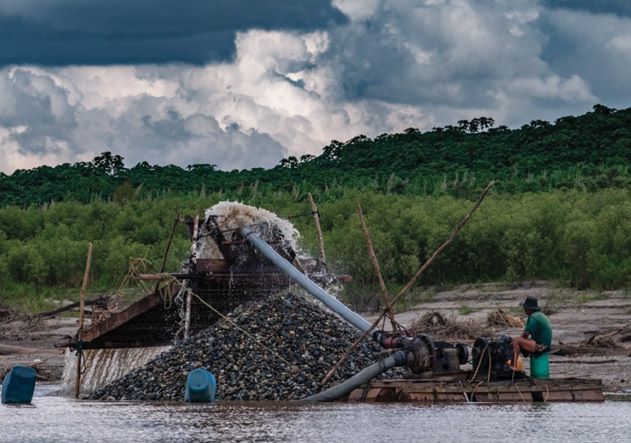
Figure 3: Artisanal miners separating gold from river sediments in Madre de Dios, Peru (Photo Credit: Jason Houston).
Mercury Extraction
The miners use water hoses attached to giant diesel-powered pumps to blast the topsoil and riverbanks. They then sift the soil to search for gold. After separating the finer sediments from the heavier gravel, they mix mercury into the slurry, which is purchased on the black market. The mercury forms an amalgam with the gold, which acts like a magnet, grabbing any remaining flecks of the precious metal. The result of the amalgamation process is a ball of 50% gold and 50% mercury, like the one shown in Figure 4, which is then heated with crude blow torches to separate the gold. This vaporizes the elemental mercury, releasing toxic mercury fumes into the atmosphere, which is absorbed into the rain forest ecosystem, and inhaled by the working miners (2).
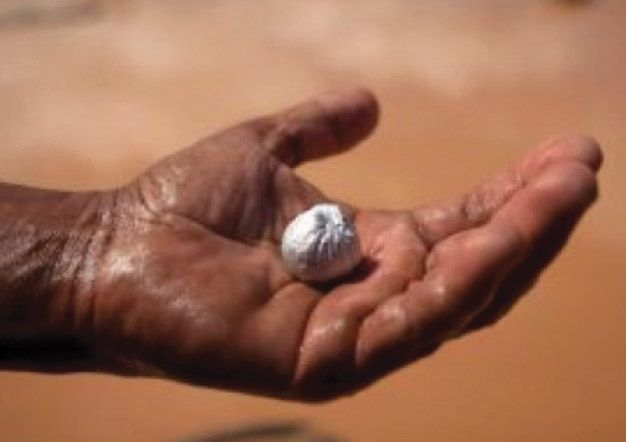
Figure 4: The mercury forms an amalgam ball with the gold (3) (Photo credit: Rodrigo Abd, Associated Press).
Impact on the Environment
The impact of gold mining on the environment of the Peruvian Amazon is devastating. Besides the deforestation and the blasting away and erosion of the soils, the mercury enters the ecosystem, including water systems, soil, and vegetation, as well as the air. This process has gone on uncontrolled more than 35 years and, as a result, the mercury is having significant repercussions on the health of the local people, contaminating their food supply, including fish, wildlife, fruits, nuts, and vegetables, as well as polluting the air they breathe.
It is well recognized, based on studies done on freshwater and ocean fish in the United States, that mercury released into the atmosphere and water systems by power plants and industrial bodies accumulates in the bottom mud and silt, where subsequently naturally occurring sulfur-reducing bacteria convert the inorganic form of mercury to the more toxic organic compound methylmercury [CH3Hg]+. Methylmercury then gets bioaccumulated and biomagnified up the food chain to the large predator fish at the top, such as tuna, swordfish, and shark in the ocean, and perch, pike, bass, and catfish in fresh water ecosystems, which eventually gets consumed by the human population.
In the Peruvian Amazon, it is estimated that gold extraction releases an estimated 185 tons of mercury directly into waterways each year. Methylmercury affects virtually every system in the human body, and often occurs with no distinctive symptoms. It impacts the central nervous system, kidneys, and reproductive organs, as well as causing chromosomal damage and severe skin reactions; at extremely high levels, methylmercury can cause coma, convulsions, and even death. The long-term effects of even low levels of methylmercury on the developing brain of young children are significant. It will cross over the blood–brain barrier as well as the placental barrier, impairing the growth of brain neurons in the fetus, resulting in cognitive damage, lower intelligence, and reduced brain development. The Minamata disaster in Japan in the late 1950s, where the Chisso Chemical Corporation dumped hundreds of tons of mercury into the Bay of Minamata for over 30 years, is a devastating testament to what happens when mercury pollution is allowed to occur (4).
High Mercury Levels
It is widely known that the presence of mercury in human hair generally indicates that a person has been exposed to methylmercury through a dietary source. Not surprisingly, high levels of mercury in hair samples were found in large numbers of Madre de Dios residents, many of which were above the reference exposure level set by the World Health Organization (WHO) (5). As a result, there is clearly a strong correlation between human mercury exposure and fish consumption (6). In fact, since 2009, studies have found high mercury levels in many species of fish, particularly in large catfish, which are a staple diet of the local people. It has been estimated that roughly two thirds of the approximately 120,000 residents of the region have been affected, many of them young children, who are the most vulnerable to mercury toxicity (7).
To get a better understanding of how mercury is having such severe impact on the health of the local people, let's take a more detailed look at the work of Professor Luis E. Fernandez in the Department of Biology at Wake Forest University in Winston Salem, North Carolina, who is leading a project to study the metal's effects on human and environmental ecosystems in the Amazon. He is also the Director of the Center for Amazonian Scientific Innovation (CINCIA) at Wake Forest, a leading research institute for environmental research, including biological conservation and environmental restoration, in the Peruvian Amazon region, which was established in 2016 through a partnership with the US Agency for International Development and the World Wildlife Fund. In this role, he leads a team of researchers who are collaborating with colleagues at the Peruvian Amazon Research Institute (Instituto de Investigacion de la Amazonia Peruana, or IIAP) and the National Amazonian University of Madre de Dios (8).
Measurement of Mercury
To carry out the assessment of the impact of mercury contamination on the region, Fernandez and his team, including Dr. Claudia Vega, who is coordinating the analytical work, established the first analytical chemistry laboratory dedicated to the study of environmental mercury in Peru. CINCIA's Mercury and Environmental Chemistry Laboratory (Laboratorio de Mercurio y Quimica Ambiental, or LAMQA) is based in the Amazonian town of Puerto Maldonado, in the gold mining region of Madre de Dios. The laboratory's main focus is to carry out mercury measurements directly on a variety of samples including fish, aquatic sediments, soil, air, and human hair, using a dual cell, direct mercury analyzer (DMA-80, Milestone Inc, Shelton, CT) to understand how mercury enters and moves through the region's food webs, and how it impacts wildlife and people. They have chosen this technique mainly because of the ruggedness of the instrument for a remote, field-based application, and the fact that very little sample preparation is required (9). Figure 5 shows CINCIA team members working in the LAMQA lab.
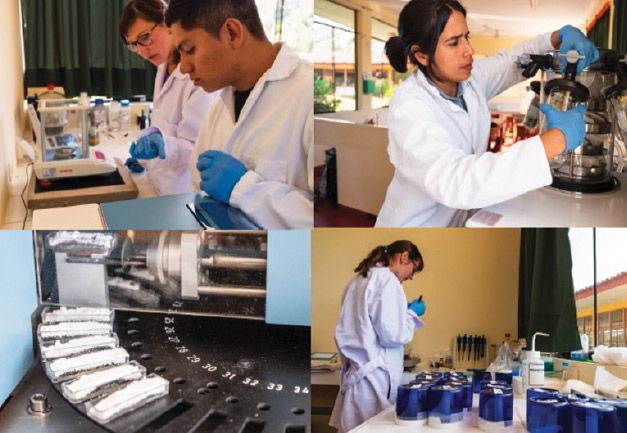
Figure 5: Dr. Vega (top right) and her team of researchers working in the Mercury and Environmental Chemistry Laboratory (LAMQA), CINCIA's field-based laboratory in Puerto Maldonado, Peru.
Direct Mercury Analyzer
It's worth discussing the principles of direct mercury analysis. The technique is used for the determination of total mercury in solid, liquid, and gas samples, using the principle of thermal decomposition, amalgamation, and atomic absorption. A decomposition furnace is used to release mercury vapor, instead of the chemical reduction step used in traditional liquid-based analyzers. Both solid and liquid matrices can be loaded onto the instrument's autosampler, and analyzed without acid digestion or sample preparation prior to analysis. Because this approach does not require the conversion of mercury to mercuric ions, lengthy sample pretreatment steps are unnecessary. As a result, there is no need for reagents such as highly corrosive acids, strong oxidizing agents, or reducing chemicals, which means no hazardous waste to be disposed of. Direct mercury analysis is a well-established analytical technique used by the environmental, biological, clinical, food, industrial, and academic communities, which has been approved by testing/standards organizations such as the U.S. Environmental Protection Agency (EPA) (10) and the American Society for Testing and Materials (ASTM) (11).
Principles of Operation
Direct mercury analysis can be broken down into four distinct sequences:
- thermal decomposition
- catalytic conversion
- amalgamation
- atomic absorption detection.
Controlled heating stages are implemented to first dry and then thermally decompose a sample introduced into a quartz tube. A continuous flow of air or oxygen carries the decomposition products through a hot catalyst bed, where halogens, nitrogen, and sulfur oxides are trapped. All mercury species are reduced to elemental mercury (Hg0), and are then carried along with reaction gases to a gold amalgamator, where the mercury is selectively trapped. All non-mercury vapors and decomposition products are flushed from the system by the continuous flow gas. The amalgamator is subsequently heated, and releases all trapped mercury to the single or double beam (depending on model), fixed wavelength atomic absorption spectrophotometer. Absorbance is measured at 253.7 nm as a function of mercury content. A schematic of the DMA-80 is shown in Figure 5.
Let's now take a more detailed look at the methodology being carried out in the field by Fernandez and his team.

Figure 6: A schematic of the DMA-80 direct mercury analyzer.
Field Methodology
A small amount of sample is weighed accurately into a sample boat, and placed on the autosampler carousel. Between 0.02 and 0.05 g of sample is typically taken, depending on the mercury content. The sample is then taken through the sampling and measurement procedure described earlier. Table I shows typical operating conditions for their fish and hair sample matrices, whereas soil and air samples use slightly modified conditions.
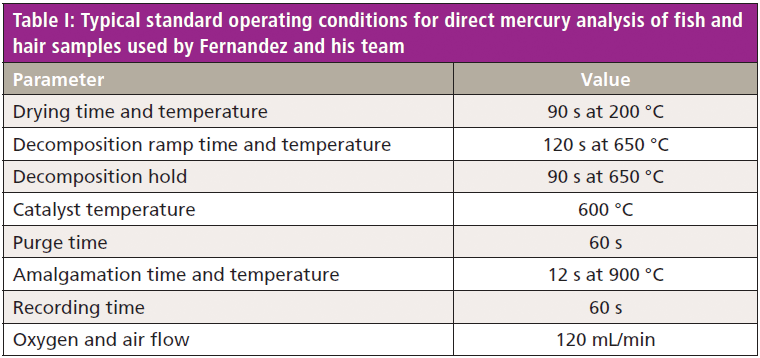
Calibration
The measurement process involves the thermal generation of mercury vapor from the sample, which means the instrument can either be calibrated with aqueous standards, or directly with solid certified reference materials (CRMs). However, the aqueous calibration methodology has been primarily adopted in their field laboratory, where standards are typically prepared using a National Institute of Standards and Technology (NIST, Gaithersburg, Maryland) traceable stock solution of 1000 ppm mercury (Hg) preserved in 5% nitric acid (HNO3). Appropriate calibration standards are then made up in 5% HNO3, and stored in a suitable vessel. By injecting increasing sample volumes of standard into the quartz sample boats, appropriate calibration graphs are created covering the range of expected mercury levels in the samples. Low and high levels of mercury in their samples are typically addressed by covering two ranges: 0–20 ng and 50-1000 ng. A portion of the 0–20 ng Hg calibration graph is shown in Figure 7.
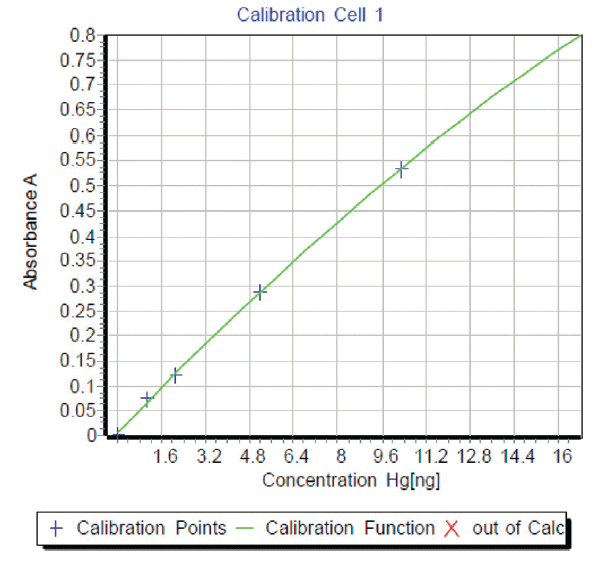
Figure 7: Direct mercury analyzer (DMA) calibration graph of 0 to 20 ng of mercury (Hg).
It is important to point out that, when quantifying lower levels of mercury, a few ppm of gold (as Cl-) is often used to stabilize the Hg, to stop it from being reduced to elemental mercury, which can be absorbed into the walls of the containers or lost when the cap is removed. The likelihood of reduction increases if the solutions are left for extended periods of time before they are analyzed (12). When gold becomes cost-prohibitive or is impractical, as it is in the Peruvian studies, sulfur ligands such as L-cysteine made up in hydrochloric acid are often used instead (13).
Data Integrity
To ensure the integrity of the data generated, the team analyzes quality control (QC) check standards (10 and 50 ng Hg) and CRMs at regular intervals during every sample run. Table II shows some typical data for two fish CRMs, DORM-4 (National Research Council of Canada, Ottawa, ON) and IAEA-436 (International Atomic Energy Authority, Vienna, Austria) generated on the DMA-80. It should be emphasized that these reference materials were analyzed together with the QC check standards every ten samples, so they represent analysis of the two CRMs approximately every hour. It can be seen that the measured results are in very good agreement with the certificate values for the two CRMs that were analyzed by a combination of isotope dilution (ID), inductively coupled plasma mass spectrometry (ICP-MS), and cold vapor atomic absorption (CVAA).

Field Studies
Let's now take a closer look at some of the real-world data being generated by Fernandez's team in their remote, field-based laboratory in Peru. It's extremely challenging to carry out field studies in a remote part of the Amazon rain forest. Equipment, materials, and utilities you take for granted in a research environment in the United States, such as electricity, air conditioning, high purity chemicals, gases, deionized water, calibration standards, CRMs, and volumetric glassware are not easy to come by in a remote, field-based environment. For that reason, instrumentation that is rugged, robust, and easy to use is of critical importance. Even making up calibration standards might not be straightforward. Therefore, the ability to carry out direct mercury analysis on solid and liquid samples is a very attractive option.
Laboratory Cleanliness
Another component we take for granted in the United States is being able to work in a contamination-free analytical environment, particularly when you are trying to quantitate at low ppb levels; that's not so easy to achieve in a remote laboratory set up in the Amazon rain forest. However, cleanliness is of prime consideration for the team's work, to ensure the data are of the highest integrity. For that reason, they have installed the DMA-80 in a cleanroom, which is separate from the rest of the lab, where sample preparation and other sampling procedures take place.
The various samples are collected and first freeze dried, which is a low temperature dehydration process involving freezing the product, lowering its pressure, then removing the ice by sublimation. This is in contrast to conventional dehydration that evaporates the water using heat. Freeze drying is a well-established technique that reduces contamination, and maintains the integrity of the sample if it has to be stored for long periods of time. After being freeze-dried, the samples are kept in a freezer until they are required for analysis on the DMA. No other preparation is required, other than weighing the sample into the sampling boat and inserting them into the automated carousel for analysis, as shown in Figure 8. For the majority of the sample matrices, they calibrate with aqueous standards using double distilled water, adding L-cysteine to stabilize the mercury.
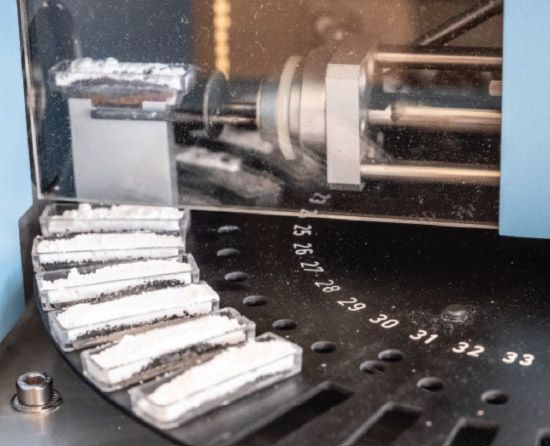
Figure 8: Samples lined up to be analyzed using DMA.
Sample Results
One of the main objectives of Fernandez and Vega's research focuses on evaluating how mercury released by artisanal gold mining affects natural and human ecosystems of the Peruvian Amazon. Through measurements of mercury concentrations in air, water, and land, and their interaction with humans, animals, and plants, they aim to evaluate the ecological impact of the gold mining. Of particular focus is assessing the potential health impact on indigenous Amazonian communities, through studies of mercury in food sources, including fish from the lakes, soils used to grow fruits, nuts, and tubers, and the air they breathe. Mercury in hair is the biomarker CINCIA is using to assess exposure levels in these vulnerable communities (14), an approach that is well documented for carrying out human ecology studies (15). The following data represent a brief snapshot of their field studies.
Mercury in Soil
A recent CINCIA study showed that uncontrolled mining has converted about 250,000 acres of rain forest to mined wastelands (16). However, very little is known about how discarded mercury from all this mining (an estimated 185 tons/year) is distributed over this landscape. To better understand this dynamic, Fernandez and Vega send teams of CINCIA researchers into the mining zone to sample soils in different areas in the mining pits. Areas left over from artisanal gold mining typically comprised three distinct categories. There are barren areas with fine tailings (such as sand and silt); barren areas of coarse tailings (gravel and cobbles); and areas of some vegetation regrowth (such as tough grasses and shrubs), which all surround deep mining pits that become filled with rain or flood water during the region's rainy season. Figure 9 shows mercury levels in soil from these three different categories, and compares them to soils from the surrounding forest as a control (17). Surprisingly, they found that, although there is a large amount of mercury released to the environment, mercury levels in the soils in abandoned mining areas are similar, or in many cases lower, than in the surrounding forest, indicating significant mobility in remnant mercury. Based on these findings, they have begun to examine mercury levels in the mining pits, which are the areas of lowest elevation in the mining landscape, and a possible sink for the mercury.
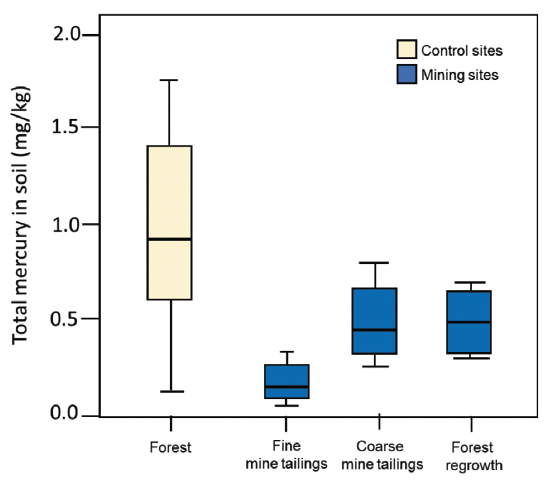
Figure 9: Mercury levels (mg/kg) of three types of soils in mined areas and in control unmined forest sites in Madre de Dios (17).
Mercury in Fish
When Fernandez and Vega began to sample sediments at the bottom of rain-filled mining pits, they found very low levels of mercury with very little difference compared with sediments from ponds outside the mining zone. However, when they started to look at mercury levels in fish, they found a difference. Figure 10 is a bar graph that compares mercury levels in mg/kg (ppm) in fish collected from two types of water bodies in Madre de Dios, by trophic level: herbivore, omnivore, and carnivore (18). The blue bars represent mercury levels of fish in rainwater-filled mining pits contaminated with mercury, and the tan bars show mercury levels in uncontaminated lakes from a pristine area in Manu National Park, about 60 km upstream from the mining zone. They made two major observations from these data. First, the mercury levels of fish from mining-impacted water bodies are two times higher than those of fish from pristine areas. Second, these data indicate that mercury is being biomagnified, because mercury levels are significantly higher in the carnivore fish that are higher up the food chain. The World Health Organization (WHO) reference level for mercury in fish (0.5 mg/kg) is represented by the red dashed line. These results provide important information, not only about what species of fish are higher in mercury, but also what types of fish in certain ponds and lakes should be avoided and which are relatively safe to eat. This last point is of critical importance in an area where wild-caught fish is by far the major source of protein for native communities and rural populations, who don't have many other alternatives.
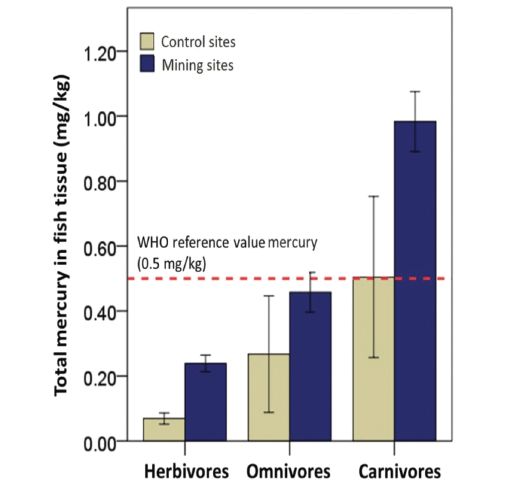
Figure 10: Mercury levels in fish across three trophic (food chain) levels in mining and control sites in the Peruvian Amazon (18).
Mercury in Air
To monitor mercury in air, Fernandez and Vega use a newly developed passive sampling method for mercury vapor that was developed by researchers at the University of Toronto (19), which relies on the natural diffusion of the airborne mercury onto an adsorbent of activated charcoal impregnated with sulfur compounds. Unlike active sampling with a pump, passive samplers are simple to use, have no moving parts, and require no electricity. It's worth pointing out that prior to analyzing the passive air samples for mercury, sodium carbonate, and aluminum hydroxide are added to the samples to minimize degradation of the instrument's catalyst tube from oxidation. In addition, the calibration curve for the passive air samples is carried out by making activated charcoal standards, the same material that is used to build the passive air samplers. Lightweight and small, these samplers are deployable in most areas, needing only a vertical support and zip ties to fix them in place. Three passive mercury samples wrapped around a tree are shown in Figure 11. This work is in its very early stages. However, preliminary results are very encouraging, and clearly show that higher airborne mercury levels are found closest to the mining areas.
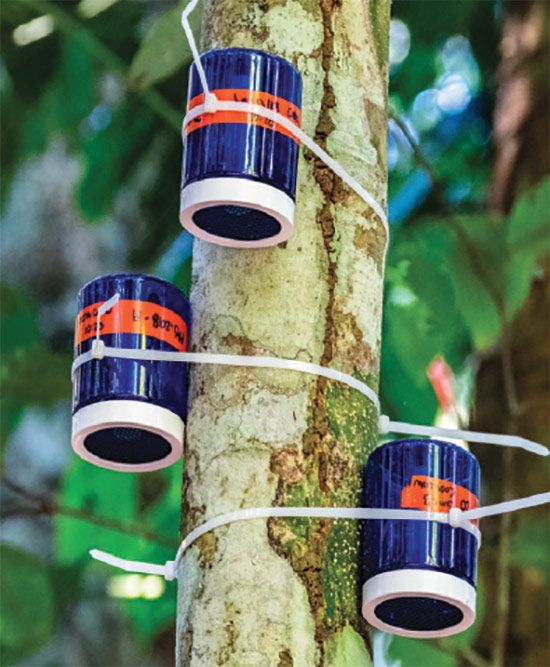
Figure 11: CINCIA's passive mercury samplers can be attached to any vertical support including street lamps, power poles, or trees (Photo credit: CINCIA).
Mercury in Hair
To take hair samples, CINCIA researchers use well established methods to ensure the analytical data are meaningful (20). Hair grows at an average rate of one cm per month, so analysis of a 4-cm segment is intended to estimate the total mercury exposure for the 4-month period preceding the analysis. Approximately 200 strands of hair, closest to the scalp, are cut using stainless steel scissors from the occipital region (back of the head) of each participant. The hair is then finely dissected, and placed in paper envelopes for storage. Approximately 20–50 mg of hair sample is then weighed accurately, and placed in the DMA-80 for analysis.
Studies by other research groups have indicated that between 40 to 77% of more than 4000 people tested in Madre de Dios have exceeded the maximum hair mercury level of 2.2 µg/g (21,22), as defined by the Provisional Tolerable Weekly Intake (PTWI) of the World Health Organization (WHO) Expert Committee on Food Additives and Contaminants (23). However, a recent study indicates that native populations may be disproportionately affected by the mercury contamination. This study showed that mean mercury levels of native populations are three times higher than those of non-native ones, with some villages among the highest mean levels of mercury measured in the western Amazon region (24). Focusing on native populations, Fernandez and Vega are in the early stages of mapping mercury levels in Amazonian native communities, and then correlating hair mercury concentrations with observations of neuro-cognitive damage, which are the hallmarks of chronic exposure to elevated levels of methyl mercury. They are also examining the villagers' diet and environment for anything that could provide any protective factor to the high levels of mercury they get through their consumption of fish. Their research represents the first of its kind in native communities, in the Peruvian Amazon, who are being studied only a few decades after their first contact with mercury.
Future Work and Final Thoughts
To the poor migrants traveling to the southeastern Peruvian Amazon rain forest looking for a better life, artisanal gold mining represents a way out of poverty. The government is trying to in vain to stop these illegal mines by destroying the mining equipment. Unfortunately, when one is discovered and destroyed, the miners just move to another location and start again.
The waste ores from all these abandoned mining sites have contaminated vast areas in Madre de Dios and similar regions across the Amazon, leading to soil deterioration, water quality losses, and a decrease in vegetation cover. As a result, Fernandez and his colleagues have started to test several environmental remediation treatments aimed at reducing the toxicity of mercury and other heavy metals. Recent CINCIA studies have shown that biochar, a unique type of charcoal production made from waste Brazil nut shells and cacao husks, which is based on native Amazonian practices nearly a thousand years old, may be a potential remediation tool for contaminated soils by increasing nutrients and water retention capacity, therefore improving acidity and stimulating the soil's microbial functions.
Additionally, the use of modern technology is also playing a significant role in the success of this project, which is being used to analyze deforestation and natural forest regeneration through satellite imagery and unmanned aerial vehicle (UAV) sensors. Fernandez and his associates have developed a fleet of these drones to characterize areas degraded by gold mining using newly developed machine learning algorithms to map the growing mining areas and the spatial distribution of mercury across the region's terrestrial and aquatic ecosystems.
Given that restoration and reforestation are likely to be part of the solution for these physically and chemically degraded landscapes, Fernandez's research team has established the largest restoration field study for areas impacted by artisanal gold mining in South America, where over 100 acres of experimental plots are being used to test the suitability of over 60 different native tree species. Computer-controlled nurseries are being set up with various native species for the ecological restoration and commercial reforestation efforts. In addition, several silvicultural treatments (the practice of controlling growth, composition, health, and quality of forests) are being evaluated for their ability to improve soil fertility and develop forest plantations.
There is no question that on-site mercury analysis is playing a significant role in ensuring that this reforestation and restoration project is being carried out in a systematic and logical manner. In particular, the technique of direct mercury analysis is proving to be of critical importance by making it possible to take the laboratory into the field to carry out the analysis in a timely manner, particularly in an extremely high workload environment. In its third year of operation, it has proved invaluable as it keeps producing high quality data, day in and day out, with the minimum of routine maintenance-a true testament to its real world applicability and ruggedness.
Acknowledgements
The author would like to acknowledge the invaluable contribution of Professor Luis Fernandez and Dr. Claudia Vega from the Center for Amazonian Scientific Innovation (CINCIA) at Wake Forest University, for their help in researching and writing this month's "Atomic Perspectives" column.
References
(1) The Modern Gold Rush That's Destroying the Amazon, The Wonder List with Bill Weir, CNN Documentary; November 17, 2017: https://www.cnn.com/2017/11/10/world/wonder-list-bill-weir-peru-amazon-illegal-gold-mining/index.html
(2) B. Fraser, Nature 534, 162 (2016).DOI: 10.1038/nature.2016.19999
(3) Going for the Gold Sends Mercury Down the River, Jason Beaubien, NPR News, January 21, 2015.
(4) D. Normile, Science 341, 1446–1447 (2013). DOI: 10.1126/science.341.6153.1446
(5) M.C. Sheehan, T.A. Burke, A.Navas-Acien, P.N. Breysse, J. McGready, and M.A. Fox, Bull. W. H. O. 92, 254–269F (2014). DOI: 10.2471/BLT.12.116152
(6) A. L. Langeland, R. D. Hardin, and R. L. Neitzel, Int. J. Environ. Res. Public Health 14(3), 302 (2017). DOI: 10.3390/ijerph14030302
(7) Mercury in Madre de Dios: Mercury Concentrations in Fish and Humans in Puerto Maldonado, L. Fernandez, Carnegie Amazon Mercury Project Research Brief No. 1, And Stanford, CA: 2013.
(8) The Center for Amazonian Science and Innovation (CINCIA) website, Wake Forest University, http://cincia.wfu.edu/en/who-we-are/
(9) DMA-80: Direct Mercury Analyzer, Milestone Inc, Shelton, CT.
(10) EPA Method 7473: Mercury in Solids and Solutions by Thermal Decomposition, Amalgamation, and Atomic Absorption Spectrophotometry, https://www.epa.gov/homeland-security-research/epa-method-7473-sw-846-mercury-solids-and-solutions-thermal-decomposition
(11) ASTM Method D6722-01: Standard Test Method for Total Mercury in Coal and Coal Combustion Residues by Direct Combustion Analysis, https://www.astm.org/DATABASE.CART/HISTORICAL/D6722-01.htm
(12) EPA Mercury Preservation Techniques, https://www.inorganicventures.com%2Fsites%2Fdefault%2Ffiles%2Fmercury_preservation_techniques.pdf&usg=AOvVaw1L5B88ZJqf3_xsL1HtgFEh
(13) H. Louie, C. Wong, Y.J. Huang, and S. Fredrickson, Anal. Methods 4, 522–529 (2012). DOI: 10.1039/C2AY05182F
(14) Mercury Exposure Prevention and Best Practices in Alluvial Gold Mining, CINCIA Reference Material, http://cincia.wfu.edu/en/category/publications/reference-material/
(15) V. A. Batzevich, Sci. Total Environ. 164(2), 89–98 (1995).
(16) J.E. Caballero, M. Messinger, F. Román-Dañobeytia, C. Ascorra, L.E. Fernandez, and M. Silman, Remote Sens. 10(12), 1903 (2018). DOI: 10.3390/rs10121903
(17) Mercury Levels in Soils of Areas Degraded by Artisanal and Small-scale Gold Mining in the Peruvian Amazon, A. van der Smissen, Thesis, University: Institut Supérieur Industriel en Agronomie de Huy, Environment Department, 2018.
(18) Mercury in Fish from Mining Ponds in Madre de Dios, Peru, C. M. Vega, J. Araujo, F. Roman, L.E. Fernandez, Center for Amazonian Scientific Innovation Research Brief No. 2, Puerto Maldonado, Madre de Dios, Peru, 2018.
(19) D.S. McLagan, C.P.J. Mitchell, H. Huang, Y.D. Lei, A.S. Cole, A. Stefen, H. Hung, and F. Wania, Environ. Sci. Tech. Let. 3, 24–29 (2016). DOI: 10.1021/acs.estlett.5b00319
(20) Guidance for identifying populations at risk from mercury exposure. World Health Organization/United Nations Environment Programme. Geneva, 2008. https://www.who.int/foodsafety/publications/risk-mercury-exposure/en/
(21) K. Ashe, PLOS ONE 7, e33305 (2012). DOI: 10.1371/journal.pone.0033305
(22) S.E. Diringer, B.J. Feingold, E.J. Ortiz, J.A. Gallis, J.M. Araújo-Flores, A. Berky, W.K.Y. Pan, and H. Hsu-Kim, Environ. Sci.: Processes Impacts 17, 478–487 (2015). DOI: 10.1039/C4EM00567H
(23) World Health Organization, Evaluations of the Joint FAO/WHO Expert Committee on Food Additives and Contaminants (JECFA); http://www.who.int/foodsafety/areas_work/chemical-risks/jecfa/en/
(24) Mercury in Madre de Dios: Mercury concentrations of human population in the Peruvian Amazon, L. Fernandez, Carnegie Amazon Mercury Project Research Brief No. 2, Stanford, CA, 2013.
Robert Thomas

Robert Thomas is the principal of Scientific Solutions, a consulting company that serves the application and writing needs of the trace element user community. He has worked in the field of atomic and mass spectroscopy for more than 40 years and has written over 90 technical publications including a 15-part tutorial series on ICP-MS. He recently completed his fourth textbook entitled Measuring Elemental Impurities in Pharmaceuticals: A Practical Guide. He has an advanced degree in analytical chemistry from the University of Wales, UK, and is also a Fellow of the Royal Society of Chemistry (FRSC) and a Chartered Chemist (CChem). He has led the heavy metals, plasma spectrochemistry task force on the ACS Committee on Analytical Reagents for the past 18 years.
